How To (Safely) Operate A Chipper-Shredder
Convicted of “Wrongful Disposal of Yard and Garden Waste” — how’s that going to look on your next job application? Sound far-fetched? Well, many communities from Florida to Oregon now prohibit the disposal of leaves, branches, garden waste and grass clippings in landfills already close to overflowing.
What to do? One option is to turn that waste into useful (or at least smaller) mulch and compost with a chipper-shredder. Whether you rent, buy or borrow, there are right and wrong ways to operate these machines.
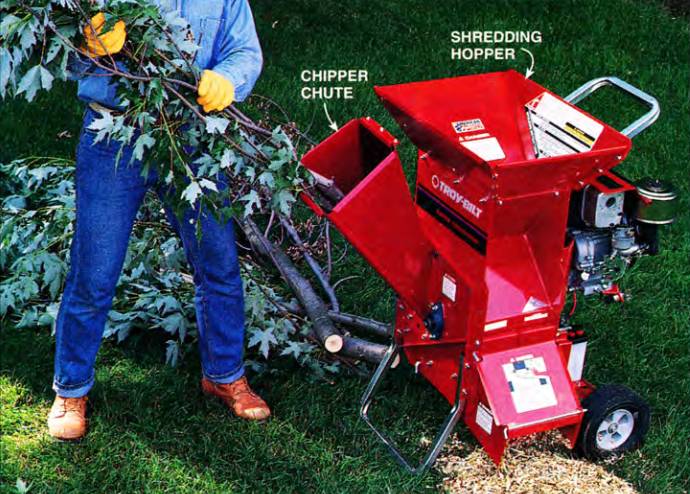
Chip and shred leaves, branches, grass and garden clippings. These machines can reduce a stack of debris to a pile a tenth its original size.
Here’s a primer.
What does a wood chipper-shredder do? How do chipper-shredders operate?
Chippers, shredders, mulchers, grinders — whatever name or combination of names they go by — do only one thing, but they do it well. They reduce branches, leaves, grass and other organic matter into small chips or flakes.
Most large, gas-powered units, like the ones examined here, are actually two machines in one:
- The smaller portion consists of a hopper into which leaves, grass clippings and small twigs are fed. Rapidly rotating teeth or hammers beneath the hopper cut or smash these materials into small pieces.
- The chipper consists of a chute into which branches (up to 3 or 4 in. in diameter) are fed. A heavy wheel with one or more heavy-duty cutting teeth chips branches into small pieces. All the materials stay in the grinding chamber (Photo 4) until they're small enough to pass through the discharge screen.
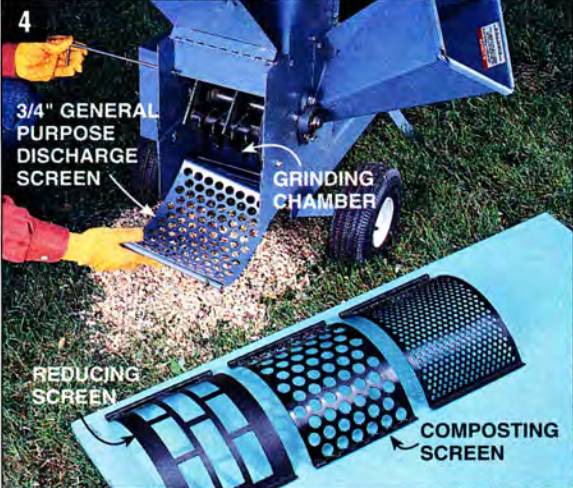
Change discharge screens to grind materials to different sizes. The reducing screen will give you wood chips and minimize clogging. The composting screen will give you finely ground material but it increases the likelihood of clogging.
How much does a chipper-shredder cost?
There are three main types of chipper-shredders:
- Small electric shredders cost around $450. They can handle leaves, grass clippings and twigs from a small yard — but don't expect them to handle branches larger than about 1 in. in diameter.
- On the middle category, chipper-shredders start from $750. These offer the best cost-benefit ratio if you have a mammoth yard or passion for collecting large tools. Stockpile the debris you want to "cut down to size," then set aside one autumn and one spring day for chipping. You can do a heap of work in a few hours.
- Even bigger machines have a vacuum attachment and will cost you up to $2,300. They are great if your garden has an overwhelming amount of leaves (Photo 5).
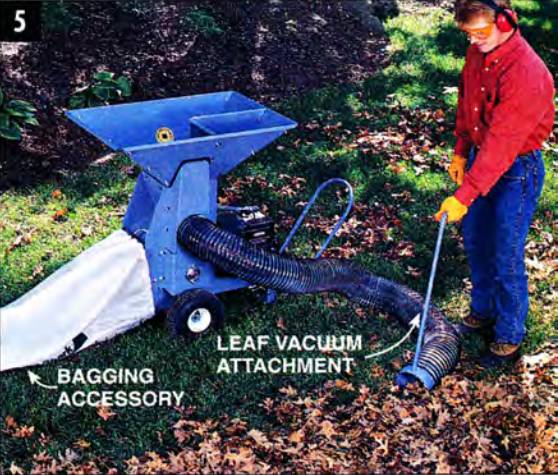
Lotsa leaves? Use a machine with a vacuum attachment and bagging accessory for quick pick-up and easy use (or disposal).
7 Tips To Safely Use A Chipper-Shredder
You’ll see warning stickers and safety devices galore because the tremendous power of these machines makes them inherently dangerous. Read and follow all manuals and bear in mind:
- When the instructions say stay in the "safety zone," they mean it (Photo 1). Half-digested pieces of wood and debris are often kicked out through the chipper chute and shredding hopper.
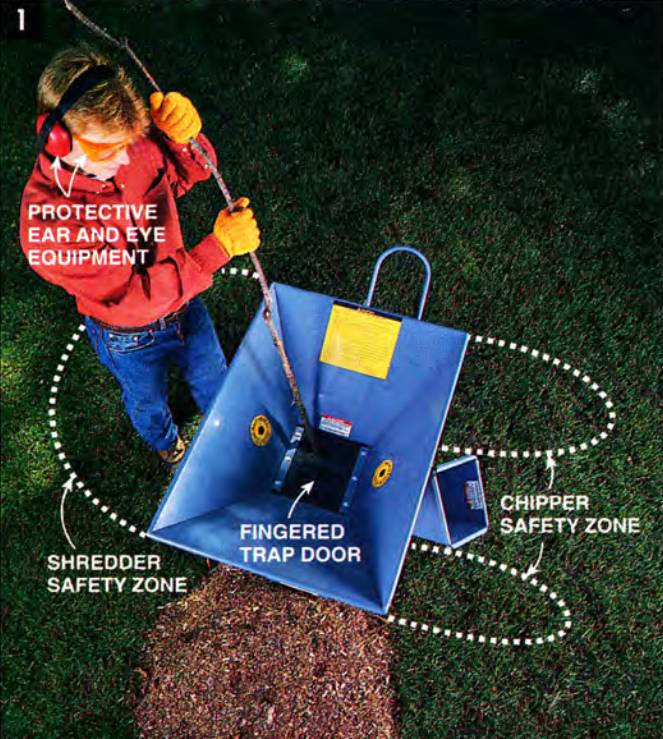
Stay in the safety zone (and wear ear and eye protection). Avoid being hit by debris discharged through the chute or hopper by staying within the designated zones.
- Keep the machine on level ground, preferably a soft surface. They're noisier and more likely to move around on concrete or asphalt surfaces.
- Watch what you feed your machine. Hidden rocks, wire and steel stakes can dull cutters, damage drive shafts, and harm you.
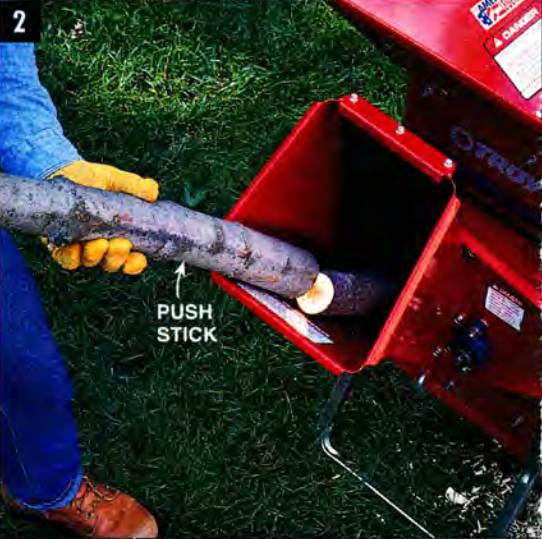
Use a push stick to feed short pieces through the chipping hopper. Hands or arms should never enter the hopper or chute. Hidden rocks, wire, and steel stakes can dull cutters, damage drive shafts, and harm you.
- Never run a branch larger than what the manufacturer specifies through the chipper or shredder. And don't give the machine too much, too fast — overfeeding is the most common reason these machines bog or break down.
- Wear goggles, a face shield or safety glasses with side shields. Hearing protection and gloves are other necessities.
- Keep your arms perpendicular to the hopper and hold branches loosely, so your arms aren't pulled in.
- Before changing the screen (Photo 4) or cleaning out the machine, wait until the machine is completely stopped, then pull off the spark plug wire.
7 Tips & Lessons I Learned Operating A Chipper-Shredder
Last spring I used a variety of chipper-shredders. While running tree limbs, leaves, pine needles, cornstalks and grass clippings through the machines, I learned:
- Make sure the machine you use is equipped with sharp chipping knives. One I rented had dull teeth; chipping a 4-ft. long branch was a bone-rattling, tough, lengthy task. I finally quit Other machines I used had sharp chipping knives; branches smoothly disappeared like carrots through a juicer. Green branches chip easier than dry ones.
- The shredding teeth really grab ahold of branches and yank them through the hopper. Be ready for this. Make sure your hands aren't entangled and that your face won't be slapped by branches being pulled in.
- The fingers or flaps on the trap doors (Photo 1) loosen and separate as the machines age; ground-up debris tends to fly back out of the machine through the hopper and the chute. Keep a bed of leaves in the hopper while grinding, to slow these flying chips.
- When shredding green leaves or garden waste, occasionally run a few small dry sticks through the shredder. This helps clean off green stringy stuff that clings to the shredding teeth and shaft. If the machine clogs frequently, use a reducing screen (Photo 4), or if the manufacturer allows it, take off the screen entirely.
- Use the fat end of a big plastic bat or a forked stick to push leaves through the safety fingers and into the shred-ding chamber (Photo 3). This keeps your hands well out of harm's way.
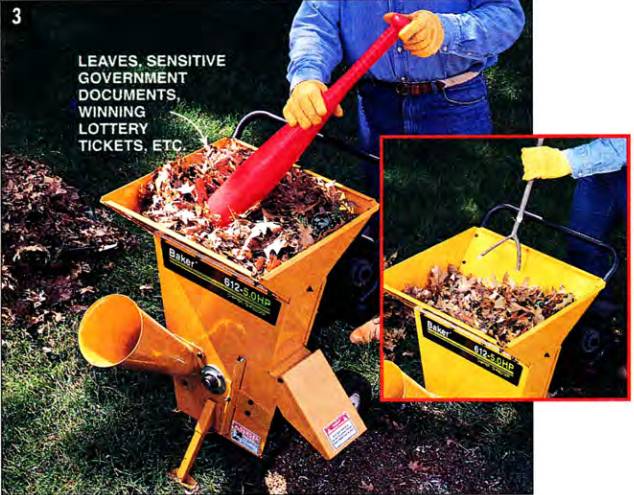
Feed leaves and garden clippings through the hopper using a plastic baseball bat, forked stick or manufacturer-supplied leaf tamper. Mix green and dry materials together to keep the material and the machine running freely.
- Many manufacturers offer both 5- and 8-hp gas models. Given the choice, get the larger one. The smaller ones are more likely to clog and bog than the 8-hp workhorses, which rarely seem to falter.
- If your machine does clog, wait until it stops, then pull off the spark plug wire and lower the discharge screen (Photo 4). Use a stick to rake debris out of the grinding chamber and away from the discharge area outside the machine.
Convicted of “Wrongful Disposal of Yard and Garden Waste” — how’s that going to look on your next job application? Sound far-fetched? Well, many communities from Florida to Oregon now prohibit the disposal of leaves, branches, garden waste and grass clippings in landfills already close to overflowing.
What to do? One option is to turn that waste into useful (or at least smaller) mulch and compost with a chipper-shredder. Whether you rent, buy or borrow, there are right and wrong ways to operate these machines.

Chip and shred leaves, branches, grass and garden clippings. These machines can reduce a stack of debris to a pile a tenth its original size.
Here’s a primer.
What does a wood chipper-shredder do? How do chipper-shredders operate?
Chippers, shredders, mulchers, grinders — whatever name or combination of names they go by — do only one thing, but they do it well. They reduce branches, leaves, grass and other organic matter into small chips or flakes.
Most large, gas-powered units, like the ones examined here, are actually two machines in one:
- The smaller portion consists of a hopper into which leaves, grass clippings and small twigs are fed. Rapidly rotating teeth or hammers beneath the hopper cut or smash these materials into small pieces.
- The chipper consists of a chute into which branches (up to 3 or 4 in. in diameter) are fed. A heavy wheel with one or more heavy-duty cutting teeth chips branches into small pieces. All the materials stay in the grinding chamber (Photo 4) until they're small enough to pass through the discharge screen.

Change discharge screens to grind materials to different sizes. The reducing screen will give you wood chips and minimize clogging. The composting screen will give you finely ground material but it increases the likelihood of clogging.
How much does a chipper-shredder cost?
There are three main types of chipper-shredders:
- Small electric shredders cost around $450. They can handle leaves, grass clippings and twigs from a small yard — but don't expect them to handle branches larger than about 1 in. in diameter.
- On the middle category, chipper-shredders start from $750. These offer the best cost-benefit ratio if you have a mammoth yard or passion for collecting large tools. Stockpile the debris you want to "cut down to size," then set aside one autumn and one spring day for chipping. You can do a heap of work in a few hours.
- Even bigger machines have a vacuum attachment and will cost you up to $2,300. They are great if your garden has an overwhelming amount of leaves (Photo 5).

Lotsa leaves? Use a machine with a vacuum attachment and bagging accessory for quick pick-up and easy use (or disposal).
7 Tips To Safely Use A Chipper-Shredder
You’ll see warning stickers and safety devices galore because the tremendous power of these machines makes them inherently dangerous. Read and follow all manuals and bear in mind:
- When the instructions say stay in the "safety zone," they mean it (Photo 1). Half-digested pieces of wood and debris are often kicked out through the chipper chute and shredding hopper.

Stay in the safety zone (and wear ear and eye protection). Avoid being hit by debris discharged through the chute or hopper by staying within the designated zones.
- Keep the machine on level ground, preferably a soft surface. They're noisier and more likely to move around on concrete or asphalt surfaces.
- Watch what you feed your machine. Hidden rocks, wire and steel stakes can dull cutters, damage drive shafts, and harm you.

Use a push stick to feed short pieces through the chipping hopper. Hands or arms should never enter the hopper or chute. Hidden rocks, wire, and steel stakes can dull cutters, damage drive shafts, and harm you.
- Never run a branch larger than what the manufacturer specifies through the chipper or shredder. And don't give the machine too much, too fast — overfeeding is the most common reason these machines bog or break down.
- Wear goggles, a face shield or safety glasses with side shields. Hearing protection and gloves are other necessities.
- Keep your arms perpendicular to the hopper and hold branches loosely, so your arms aren't pulled in.
- Before changing the screen (Photo 4) or cleaning out the machine, wait until the machine is completely stopped, then pull off the spark plug wire.
7 Tips & Lessons I Learned Operating A Chipper-Shredder
Last spring I used a variety of chipper-shredders. While running tree limbs, leaves, pine needles, cornstalks and grass clippings through the machines, I learned:
- Make sure the machine you use is equipped with sharp chipping knives. One I rented had dull teeth; chipping a 4-ft. long branch was a bone-rattling, tough, lengthy task. I finally quit Other machines I used had sharp chipping knives; branches smoothly disappeared like carrots through a juicer. Green branches chip easier than dry ones.
- The shredding teeth really grab ahold of branches and yank them through the hopper. Be ready for this. Make sure your hands aren't entangled and that your face won't be slapped by branches being pulled in.
- The fingers or flaps on the trap doors (Photo 1) loosen and separate as the machines age; ground-up debris tends to fly back out of the machine through the hopper and the chute. Keep a bed of leaves in the hopper while grinding, to slow these flying chips.
- When shredding green leaves or garden waste, occasionally run a few small dry sticks through the shredder. This helps clean off green stringy stuff that clings to the shredding teeth and shaft. If the machine clogs frequently, use a reducing screen (Photo 4), or if the manufacturer allows it, take off the screen entirely.
- Use the fat end of a big plastic bat or a forked stick to push leaves through the safety fingers and into the shred-ding chamber (Photo 3). This keeps your hands well out of harm's way.

Feed leaves and garden clippings through the hopper using a plastic baseball bat, forked stick or manufacturer-supplied leaf tamper. Mix green and dry materials together to keep the material and the machine running freely.
- Many manufacturers offer both 5- and 8-hp gas models. Given the choice, get the larger one. The smaller ones are more likely to clog and bog than the 8-hp workhorses, which rarely seem to falter.
- If your machine does clog, wait until it stops, then pull off the spark plug wire and lower the discharge screen (Photo 4). Use a stick to rake debris out of the grinding chamber and away from the discharge area outside the machine.
